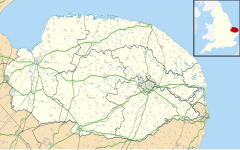Flitcham, Norfolk
| Flitcham | |
|---|---|
 Saint Mary's parish church, Flitcham. |
|
| Flitcham shown within Norfolk | |
| Population | 276 (parish, 2011 census) |
| OS grid reference | TF7226 |
| • London | 112 miles (180 km) |
| Civil parish |
|
| District | |
| Shire county | |
| Region | |
| Country | England |
| Sovereign state | United Kingdom |
| Post town | KINGS LYNN |
| Postcode district | PE31 |
| Dialling code | 01485 |
| Police | Norfolk |
| Fire | Norfolk |
| Ambulance | East of England |
| EU Parliament | East of England |
| UK Parliament | |
Flitcham is a village within the civil parish of Flitcham with Appleton in the English county of Norfolk. The village is 45.5 miles (73.2 km) north-west of Norwich, 9.1 miles (14.6 km) north-east of King’s Lynn and 112 miles (180 km) north of London. The village straddles the B1153 road just to the north of the A148 Fakenham Road at Hillington. The nearest railway station is at King’s Lynn for the Fen Line which runs between King’s Lynn and Cambridge. The parish of Flitcham with Appleton in the 2011 census, had a population of 276 in 121 households. For the purposes of local government, the parish falls within the district of King's Lynn and West Norfolk. Together with the villages of West Newton, Shernborne, and Anmer, it is part of the Royal Sandringham Estate.
The parish of Flitcham with Appleton within which the village is located is a large parish which is in the north west of Norfolk. To the east the parish boundary is discernible by the route of the Peddars Way, the long distance footpath which follows the route of a Roman road. On the southern boundary is the River Babingley whose source is close to the village and runs to the River Great Ouse at Wootton Marshes. The northern boundary is with the civil parish of Anmer, whilst the parish and royal estate of Sandringham lie to the west. The village of Flitcham is in the south of the parish. Also within the parish is the hamlet of Appleton, a lost village which has now dwindled to a few dwellings and a church in a ruinous state. The name Flitcham derives from the Old English meaning a homstead or village where flitches of bacon are produced.
...
Wikipedia

